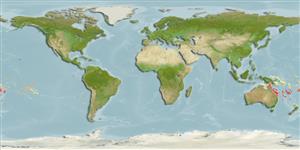>
Ovalentaria/misc (Various families in series Ovalentaria) >
Plesiopidae (Roundheads) > Plesiopinae
Etymology: Plesiops: Greek, plesios = near + Greek, ops = appearance (Ref. 45335); insularis: From the the Latin word meaning 'of islands', referring to the present distribution of the species , in the islands of the New Caledonia Basin region.
More on authors: Mooi & Randall.
Environment: milieu / climate zone / depth range / distribution range
Ökologie
seewasser riff-verbunden; tiefenbereich 0 - 25 m (Ref. 27772), usually 2 - 25 m (Ref. 27772). Temperate
Southwest Pacific: islands in the Coral and Tasman seas, including Lord Howe Island and the nearby Elizabeth and Middleton reefs, Norfolk Island, New Caledonia, and Chesterfield Bank. Western Central Pacific (Ref. 12926). Recently reported from Tonga (Ref. 53797).
Size / Gewicht / Alter
Maturity: Lm ? range ? - ? cm
Max length : 9.8 cm SL Männchen/unbestimmt; (Ref. 27772)
Adults inhabit coral reef (Ref. 75154) and tide pools (Ref. 27772). Benthic (Ref. 75154). Eggs are guarded by the male parent (Ref. 205).
Life cycle and mating behavior
Geschlechtsreife | Fortpflanzung | Ablaichen | Eier | Fecundity | Larven
Eggs are guarded by the male parent (Ref. 205).
Mooi, R.D., 1995. Revision, phylogeny, and discussion of biology and biogeography of the fish genus Plesiops (Perciformes: Plesiopsidae). Life Sci. Contrib. No. 159, 108 p. (Ref. 27772)
IUCN Rote Liste Status (Ref. 130435: Version 2024-2)
Bedrohung für Menschen
Harmless
Nutzung durch Menschen
Tools
Zusatzinformationen
Download XML
Internet Quellen
Estimates based on models
Preferred temperature (Ref.
123201): 24.4 - 27.3, mean 26.1 °C (based on 94 cells).
Phylogenetic diversity index (Ref.
82804): PD
50 = 0.5000 [Uniqueness, from 0.5 = low to 2.0 = high].
Bayesian length-weight: a=0.01202 (0.00501 - 0.02886), b=2.98 (2.77 - 3.19), in cm total length, based on LWR estimates for this (Sub)family-body shape (Ref.
93245).
Trophic level (Ref.
69278): 3.5 ±0.5 se; based on size and trophs of closest relatives
Widerstandsfähigkeit (Ref.
120179): hoch, Verdopplung der Population dauert weniger als 15 Monate. (Preliminary K or Fecundity.).
Fishing Vulnerability (Ref.
59153): Low vulnerability (10 of 100).
Nutrients (Ref.
124155): Calcium = 37.8 [14.8, 72.2] mg/100g; Iron = 0.269 [0.144, 0.487] mg/100g; Protein = 19.2 [18.1, 20.3] %; Omega3 = 0.427 [0.215, 0.862] g/100g; Selenium = 4.43 [1.88, 10.37] μg/100g; VitaminA = 120 [30, 489] μg/100g; Zinc = 0.876 [0.547, 1.371] mg/100g (wet weight);
